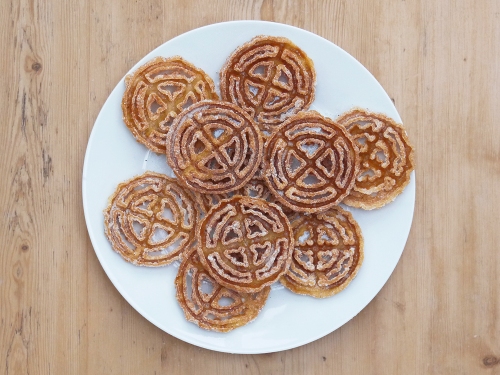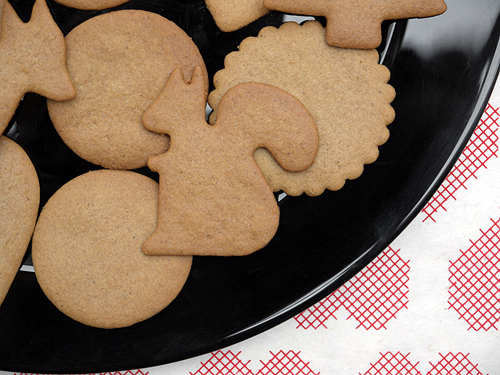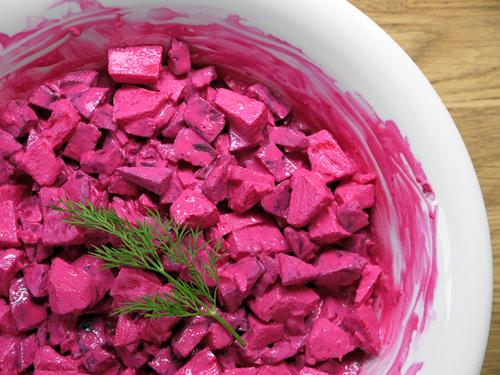When I made my Slovak ginger cookies I boasted proudly that I had not bought a special cutter to make them. This was not due to some new-found restraint on my part, but because I had already bought my novelty baking item for the year. That item was a rosette iron, which is used to make light, crisp, fried cookies in intricate patterns.

In English these are called rosette cookies and are popular in parts of the US with Scandinavian heritage. They appear with similar fancy patterns in Norway and Denmark, and as funnel cakes in Finland, but I’ve gone with the Swedish name struvor as I’ve lived in Sweden, and have used the recipe from Johanna Kindvall at Kokblog as my inspiration this year.

I must admit making fried cookies is a style of baking I’m not familiar with. I’m all for enjoying a donut or fried snacks, but making them at home tends to leave me a bit uneasy as I’ve got a bit of a fear of cooking things in a big bubbling vat of oil. But in a year that has made doing many things impossible, I felt it was right to give them a go. I also made sure I had suitable fire safety equipment in my kitchen, so I felt a bit happier with the big sizzling pan knowing that I was probably not going to set fire to the house (spoiler: the house is still fine).
While they look complex, they are actually quite easy to make if you have the equipment and enough time. But this is not a recipe to make when you have pets or small children running around! The mixture is similar to pancake batter, so takes just a few minutes to mix up. You then heat the rosette iron in the oil, then when it is very hot, you dip it carefully into the batter. A thin layer of the batter will cook on impact, and then when you put the iron back into the oil, the cookie will release itself from the iron and fry to a golden colour.
I learned from experience that you need to let the rosette iron get very hot in the oil before you start. My first two attempts were really bad – the iron was not hot, so the dough did not stick, and they were a complete mess. It was just trial and error that helped me work out how to do it properly. Apart from that, the only advice I can offer is to make sure you have lots of kitchen paper on plates to drain excess oil from the cookies, and to make sure you’re able to open lots of doors and windows so your house does not enjoy the lingering aroma of cooking oil! Once you’ve got the knack, you’ll be able to turn out plate after plate of these little guys.

With the frying part done, I finished my struvor off in a few different ways. Some were dusted with icing sugar, and they were delicious. I dipped some others in cinnamon sugar and a few I finished off with sugar and ground cardamom. All tasted good, but my favourite (and the one recommended by Johanna) was the cardamom. It is a fresh, citrussy flavour that brings a bit of zing to these cold dark days.
So, how are they? Really, really great. They’re crisp, sweet and really feel very festive. They’re certainly not something you would eat every day, but that’s pretty much the point isn’t it? They transported me to a Christmas market where some sort of sweet, fried delight is de rigueur.
Struvor are best made fresh, but if you struggle to eat them all in one sitting (which is easy as even a small batch can easily run to 30…) you can store them if you don’t put sugar on them right away. Put them in an airtight container and pop them in the freezer, then revive them in a warm oven when you’re ready to eat them. While they’re not quite as good as when freshly made, they will regain their crispness and a sprinkling of sugar will revive their charm.
To make Struvor (makes around 30), based on the recipe on Kokblog
For the batter
• 150ml whole milk
• 1 tablespoon cream
• 1 egg
• pinch of salt
• 2 tablespoons lager
• 90g plain flour
• 300ml vegetable oil, to fry
To finish
• icing sugar, cardamom sugar or cinnamon sugar
1. Prepare your work area. Layer several sheets of kitchen roll on a couple of large baking sheets.
2. Make the batter. In a large bowl, beat the egg. Add the milk, cream, salt and lager and. Finally add the flour and salt and mix until smooth. Leave for 10 minutes to rest.
3. Get your sugar ready. Mix caster sugar with spices of your choice, and spread out on a plate. If using icing sugar, put some into a small sieve and keep close at hand.
4. Time to fry! Put the oil into a saucepan, and heat to 180°C. When up to temperature, dip the rosette iron into the oil to heat it – you want it to be good and hot, so leave for at least 30 seconds. Take the iron out, and dip just the bottom part of the iron into the batter (be careful that it does not come all the way up and cover the iron, or the cookies will not form).
5. Put the iron back into the oil, and submerge the batter in the oil. The cookie should start to peel off like magic, but you may need to give it a little helping hand with a knife.
6. Let the cookie fry for a few seconds, then turn it over and cook for another few seconds until golden. Remove the cookie from the pan, allow excess oil to drain, then transfer to the tray lined with kitchen roll. Allow to cool for a moment.
7. If using cardamom or cinnamon sugar: press one side of the still-warm cookie into the sugar, then leave to one side to cool completely. Now start with the next cookie…
8. If using icing sugar: when you’ve cookies all your cookies, dredge liberally with icing sugar.


































